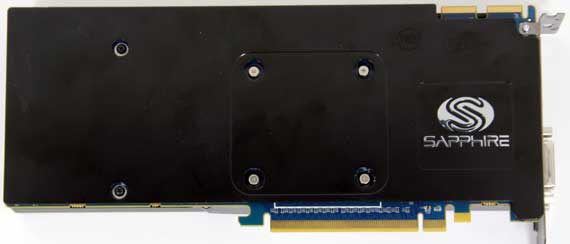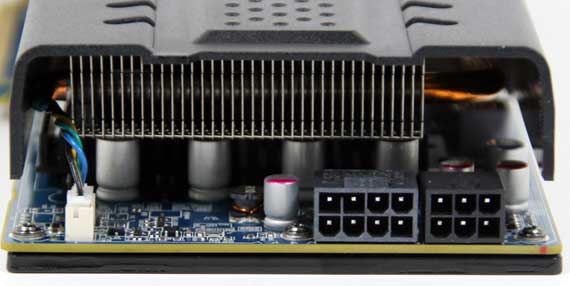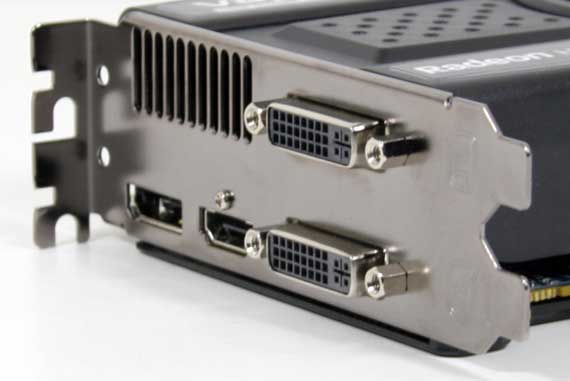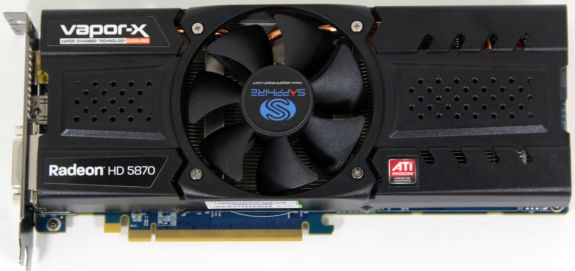Overclocked: Our Custom Radeon HD 5870 Roundup
by Ryan Smith on May 19, 2010 11:53 AM ESTSapphire Radeon HD 5870 Toxic 2GB
We’ll start things off with Sapphire’s Radeon HD 5870 Toxic. The 5870 Toxic 2GB is Sapphire’s shot at a custom 2GB Radeon HD 5870, forgoing AMD’s 5870E6 design for a design of their own. In this case Sapphire has ditched the Eyefinity 6 concept entirely, opting to build a card closer to a regular 5870 with 2GB of RAM. The result is a card that’s best described as a 2GB 5870, rather than a 5870E6.
The Toxic gets Sapphire’s customary touch, equipping the card with one of their famous Vapor-X coolers, the cornerstone of which is the use of a vapor chamber in the cooling assembly’s baseplate. The entire assembly is a card-sized aluminum heatsink connected to the baseplate by 3 heatpipes, with a 92mm fan in the center. Meanwhile the back of the card has a plate on it to serve double-duty as both a decoration and as a heatsink for the 8 128MB GDDR5 RAM modules on the back of the PCB. As with their other Vapor-X cooler products, the Vapor-X cooler on the Toxic is a partially covered design that blows air towards both the front and the rear of the card, so you’ll need a well-ventilated case for this card.

Moving on to the PCB, as with everything else this is a custom Sapphire design, a new design necessary to fit the extra 1GB of RAM. The card is 10.15” in length, making it shorter than the reference 5870. Unfortunately Sapphire also kept up their tradition of putting the PCIe power sockets on the rear of the card instead of the top, so it’s really 10.15” plus whatever room you need to maneuver your power cords. Speaking of which, since this is a 2GB 5870, the 5870 Toxic 2GB requires both 8pin and 6pin PCIe power to operate.

For component selection, Sapphire has decided to focus on their use of chokes and capacitors. Once again we see Sapphire’s grooved “Black Diamond” solid state chokes, and all of their capacitors are solid capacitors. As is the case with the rest of the cards in this roundup, this is as much a technical matter as it is a marketing matter: the reference 5870 design already uses solid state chokes and solid capacitors. So the difference comes down to component selection, with Sapphire using their higher quality chokes.
Sapphire is once again targeting the factory overclock market with the Toxic, shipping the card with a core clock of 925MHz and a memory clock of 1.225GHz (4.9GHz effective) – 75MHz and 100MHz faster than the stock 5870’s core and memory respectively. Since Sapphire isn’t targeting overclockers with this card it should come as no surprise that there’s little in the way of overclocking features for it. There is a generous overdrive limit of 1000/1500 for the card, but as it’s using Sapphire’s unprogrammable VRMs, there’s no way to change the GPU voltage. Making up for that is the card’s slightly higher default core voltage of 1.2v, necessary to drive the card’s higher core clock.

The included materials are also sparse: drivers, AnySim HD, power adapters, a VGA dongle, a CF bridge, and a generic multilingual manual.
Since this is not an Eyefinity 6 edition card, the port configuration is AMD’s standard Eyefinity configuration: 2xDVI, 1x DP, and 1x HDMI. The 2GB of RAM should also be of some help when it comes to Eyefinity, however as we saw in our 5870E6 review it’s limited at best.

The retail price of the card is around $500 – we briefly saw it at $489 before it went out of stock. Compared to the other cards in this roundup, the Toxic is going to be the hardest to find, as it’s currently out of stock everywhere we’ve checked. When in stock however, it’s priced close enough to the 5870E6 that they’re substitute products, so if you’re willing to give up 3 mini-DisplayPorts, you can get a factory overclocked 5870 instead.











43 Comments
View All Comments
KayDat - Wednesday, May 19, 2010 - link
An interesting result...but looking at some other 5870 reviews, OC3D reviewed an XFX 5870 xXx edition ( http://www.overclock3d.net/reviews/gpu_displays/xf... ), which is an OC oriented card based off reference design, and they managed to get a 984MHz overclock, along with the cards stock 1300MHz memory. Would be interesting if you could take a look at that card as well.Nimiz99 - Wednesday, May 19, 2010 - link
on the page for overall OC results it readsSapphire Toxic 2GB: 600/1250
MSI Lighting: 940/1300
Gigabyte Super Overclock: 950/1325
i think the saphire should be 960
---
BTW, thank you for giving us a quick overview of the OC advantage over stock speeds. It's something I am always interested in to see if paying for the OC ability is worth it.
Great article
Earthmonger - Wednesday, May 19, 2010 - link
I was really hoping these OCs would conquer the stock GTX 480. I've been looking for a reason to NOT go nVidia this round. As a water cooler, noise and heat are irrelevant to me. Power is my only concern. 170w vs 190w at idle, and within 50w at load (Crysis)... I'm not sure that small of a difference is enough justification to buy a slower GPU.PS, in the test setup you list the NVIDIA GeForce GTX 260 Core 216, but have no results for it in any of the tests. Typo?
MadMan007 - Wednesday, May 19, 2010 - link
It looks to me like the power draw penalty for 2GB on the Sapphire card is ~25W. Is there something else like clock speeds that are somehow being factored in or was this just a mistake?BlendMe - Wednesday, May 19, 2010 - link
That's a 92mm not cm fan on the sapphire.Rick83 - Wednesday, May 19, 2010 - link
and 80 mm (again, not cm) on the MSI...BlendMe - Wednesday, May 19, 2010 - link
and on the Gigabyte as well...Ryan Smith - Wednesday, May 19, 2010 - link
If I'm going to be wrong, at least I'm going to be consistently wrong.marc1000 - Thursday, May 20, 2010 - link
LOL!!!!!every now and then, there is some joke here that makes me laugh... good article btw!
about the overcloks, it looks like a future re-spin of the cypress running at 1ghz could overcome the Fermi.... it would be fun to see a 2 billion transistor GPU running faster than a 3 billion one....
Voo - Thursday, May 20, 2010 - link
The thing is compared to Cypress Fermi overclocks exceptionally well, especially considering the fact that when it first appeared I don't think anyone thought it would. Seems like Fermi should profit a lot more from a die shrink than cypress, but let's see what NI brings to the table.